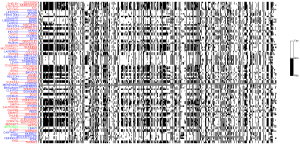Senate voting data matrix.
The data consists of the votes of ![]() Senators in the 2004-2006 US Senate (2004-2006), for a total of
Senators in the 2004-2006 US Senate (2004-2006), for a total of ![]() bills. “Yay” (“Yes”) votes are represented as 1‘s, “Nay” (“No”) as -1‘s, and the other votes are recorded as 0. (A number of complexities are ignored here, such as the possibility of pairing the votes.)
bills. “Yay” (“Yes”) votes are represented as 1‘s, “Nay” (“No”) as -1‘s, and the other votes are recorded as 0. (A number of complexities are ignored here, such as the possibility of pairing the votes.)
This data can be represented here as a ![]() ‘‘voting’’ matrix
‘‘voting’’ matrix
![]()
with elements taken from ![]() . Each column of the voting matrix
. Each column of the voting matrix ![]() contains the votes of a single Senator for all the bills; each row contains the votes of all Senators on a particular bill.
contains the votes of a single Senator for all the bills; each row contains the votes of all Senators on a particular bill.

